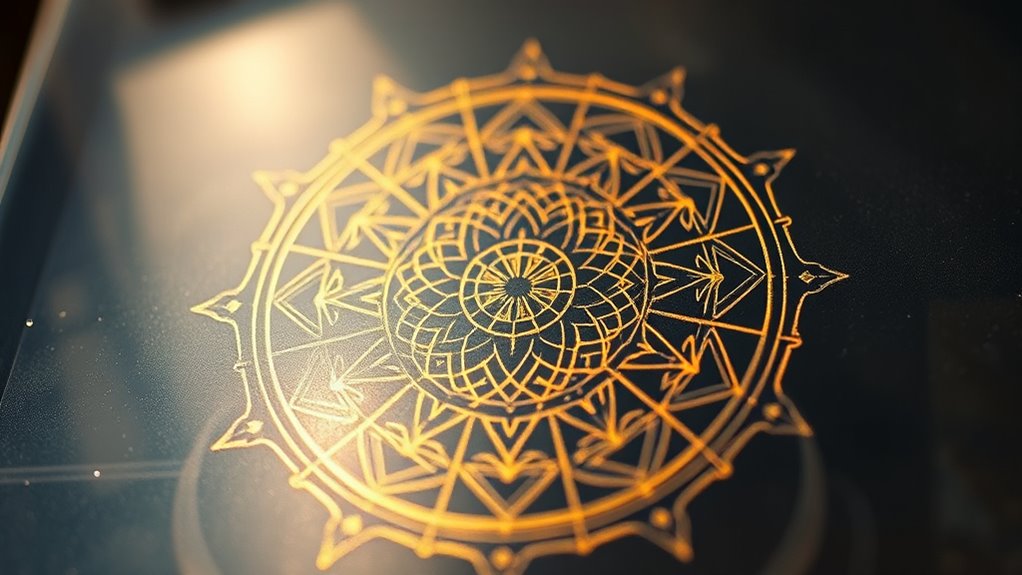Sacred geometry connects you to universal truths through the shapes and patterns that embody spiritual principles. Circles symbolize unity and eternity, triangles represent harmony and spiritual connection, while spirals illustrate growth and evolution. These shapes are embedded in architecture and art, serving as metaphors for your spiritual journey and the divine order of the cosmos. Exploring their deeper meanings reveals how they link your consciousness with higher dimensions—continue to explore and uncover the profound wisdom they hold.
Key Takeaways
- Geometric shapes like circles, triangles, and spirals symbolize universal principles such as unity, harmony, and growth, reflecting spiritual truths.
- Sacred geometry acts as a bridge between material reality and divine understanding, facilitating higher consciousness and spiritual connection.
- Shapes serve as visual metaphors for spiritual journeys, interconnectedness, and the divine order governing the universe.
- Embedded in sacred architecture, these forms elevate consciousness and embody cosmic principles through precise geometric design.
- Recognizing sacred geometry’s patterns aligns individuals with universal laws, revealing profound spiritual and cosmic truths.

Have you ever wondered how ancient cultures found harmony and meaning in the shapes around them? It’s because they recognized that certain geometric forms hold more than just aesthetic appeal—they embody deeper spiritual truths. These shapes, often called spiritual patterns, serve as a bridge between the material and the divine. Through the lens of sacred geometry, you can see how mathematical symbolism becomes a language conveying universal principles. Shapes like circles, triangles, and spirals aren’t random; they reflect fundamental aspects of existence, from creation to interconnectedness. Cultures across the globe, from the Egyptians to the Greeks, used these forms to express their understanding of the cosmos. They believed that these geometric patterns encapsulate the divine order of the universe, giving them a way to connect with higher consciousness.
When you explore sacred geometry, you notice that these shapes aren’t just artistic choices—they’re symbols loaded with meaning. The circle, for example, represents unity, wholeness, and eternity. It’s a spiritual pattern that emphasizes the unending cycle of life, death, and rebirth. The triangle often symbolizes balance and harmony, pointing to the trinity or the connection between body, mind, and spirit. Spirals, which recur in nature from galaxies to shells, embody growth, evolution, and the journey inward or outward. These forms act as visual metaphors for spiritual journeys, guiding your understanding of your place in the universe. They help you see that everything is interconnected through a web of divine proportions, expressed through mathematical symbolism.
Ancient builders and artists embedded these geometric principles into their sacred structures, making the architecture itself a reflection of spiritual patterns. When you walk into a cathedral or a temple, you’re often stepping into a space designed with these principles, intended to elevate your consciousness. Sacred geometry isn’t just about symmetry or beauty; it’s about conveying universal truths. By understanding these forms, you gain insight into how humans have historically sought harmony with the divine. The shapes serve as a reminder that the universe operates on a set of sacred laws, and that through recognizing these patterns, you can align yourself with the greater cosmic order. Fundamentally, sacred geometry reveals that the universe’s most profound truths are written in the language of shapes—an eternal dialogue between the physical and spiritual domains.
Frequently Asked Questions
How Does Sacred Geometry Influence Modern Architectural Design?
You see sacred geometry influencing modern architecture through the use of mathematical proportions and visual harmony. Architects incorporate these principles to create structures that feel balanced and aesthetically pleasing. By applying geometric shapes and ratios like the golden ratio, they evoke a sense of timeless beauty and spiritual connection. This approach results in buildings that not only serve functional purposes but also inspire and uplift those who experience their design.
Are There Specific Cultures That Emphasize Sacred Geometric Symbols More Than Others?
You’ll find that many cultures celebrate sacred geometric symbols more than others. For example, Hindu and Buddhist traditions emphasize intricate mandalas, while Islamic art avoids figurative images, focusing on geometric patterns. These cultural symbols serve spiritual traditions, shaping sacred spaces and spiritual stories. By blending bold shapes and balanced patterns, these cultures deepen their spiritual practices, demonstrating a profound respect for sacred geometry’s power to connect the physical and divine worlds.
Can Sacred Geometry Be Used for Personal Spiritual Practices or Meditation?
Yes, you can use sacred geometry for personal spiritual practices or meditation. By focusing on geometric shapes like the Flower of Life or the Sri Yantra, you enhance your meditative practices, helping you achieve deeper states of awareness. These shapes serve as visual tools for personal growth, allowing you to connect with universal energies and foster mindfulness. Incorporate sacred geometry into your routines to deepen your spiritual journey and promote inner harmony.
What Is the Historical Origin of the Flower of Life Pattern?
You discover that the Flower of Life pattern has ancient symbolism rooted in various cultures like Egyptian and Chinese, dating back thousands of years. Its mathematical origins involve complex geometric principles, representing interconnectedness and harmony. This pattern appears in sacred sites and artifacts, suggesting it holds deep spiritual meaning. Its enduring presence highlights its significance as a symbol of creation, unity, and the universe’s fundamental structure across history.
How Do Sacred Shapes Relate to Universal Constants Like Pi and Phi?
Think of sacred shapes as the universe’s secret language, connecting to mathematical constants like pi and phi. These constants define geometric proportions that appear in nature and ancient art, symbolizing harmony and balance. When you see shapes like circles and spirals, you’re witnessing the same principles that govern solar systems and DNA. Sacred geometry reveals how universal constants underpin the structure of everything, blending science and spirituality into a beautiful, unified design.
Conclusion
As you explore sacred geometry, imagine yourself stepping into a radiant mandala, every shape a whisper of ancient wisdom guiding your soul. Feel the harmony of spirals and circles swirling around you, connecting you to the universe’s timeless dance. These sacred forms aren’t just patterns—they’re gateways to deeper understanding and spiritual awakening. Embrace their beauty, let them inspire your journey, and discover the divine symphony woven into every geometric shape.










